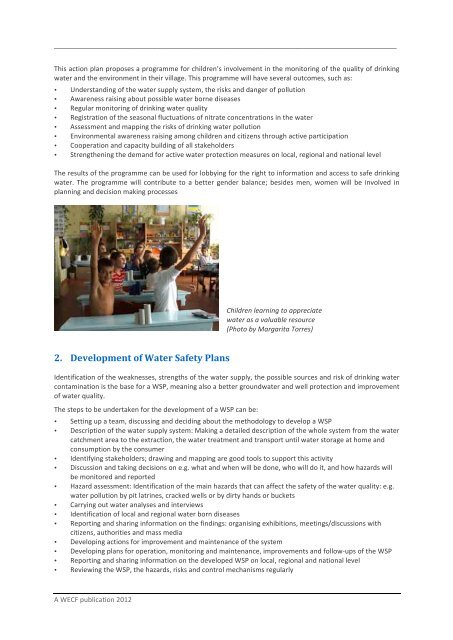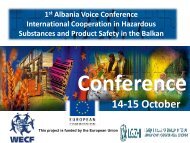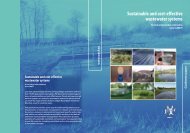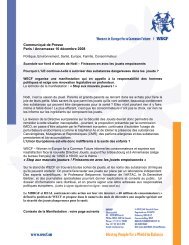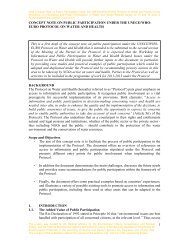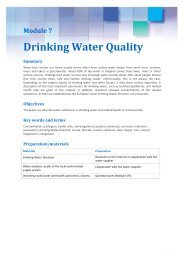Local Action for Safe Water - WECF
Local Action for Safe Water - WECF
Local Action for Safe Water - WECF
You also want an ePaper? Increase the reach of your titles
YUMPU automatically turns print PDFs into web optimized ePapers that Google loves.
___________________________________________________________________________<br />
This action plan proposes a programme <strong>for</strong> children’s involvement in the monitoring of the quality of drinking<br />
water and the environment in their village. This programme will have several outcomes, such as:<br />
• Understanding of the water supply system, the risks and danger of pollution<br />
• Awareness raising about possible water borne diseases<br />
• Regular monitoring of drinking water quality<br />
• Registration of the seasonal fluctuations of nitrate concentrations in the water<br />
• Assessment and mapping the risks of drinking water pollution<br />
• Environmental awareness raising among children and citizens through active participation<br />
• Cooperation and capacity building of all stakeholders<br />
• Strengthening the demand <strong>for</strong> active water protection measures on local, regional and national level<br />
The results of the programme can be used <strong>for</strong> lobbying <strong>for</strong> the right to in<strong>for</strong>mation and access to safe drinking<br />
water. The programme will contribute to a better gender balance; besides men, women will be involved in<br />
planning and decision making processes<br />
2. Development of <strong>Water</strong> <strong>Safe</strong>ty Plans<br />
A <strong>WECF</strong> publication 2012<br />
Children learning to appreciate<br />
water as a valuable resource<br />
(Photo by Margarita Torres)<br />
Identification of the weaknesses, strengths of the water supply, the possible sources and risk of drinking water<br />
contamination is the base <strong>for</strong> a WSP, meaning also a better groundwater and well protection and improvement<br />
of water quality.<br />
The steps to be undertaken <strong>for</strong> the development of a WSP can be:<br />
• Setting up a team, discussing and deciding about the methodology to develop a WSP<br />
• Description of the water supply system: Making a detailed description of the whole system from the water<br />
catchment area to the extraction, the water treatment and transport until water storage at home and<br />
consumption by the consumer<br />
• Identifying stakeholders; drawing and mapping are good tools to support this activity<br />
• Discussion and taking decisions on e.g. what and when will be done, who will do it, and how hazards will<br />
be monitored and reported<br />
• Hazard assessment: Identification of the main hazards that can affect the safety of the water quality: e.g.<br />
water pollution by pit latrines, cracked wells or by dirty hands or buckets<br />
• Carrying out water analyses and interviews<br />
• Identification of local and regional water born diseases<br />
• Reporting and sharing in<strong>for</strong>mation on the findings: organising exhibitions, meetings/discussions with<br />
citizens, authorities and mass media<br />
• Developing actions <strong>for</strong> improvement and maintenance of the system<br />
• Developing plans <strong>for</strong> operation, monitoring and maintenance, improvements and follow-‐ups of the WSP<br />
• Reporting and sharing in<strong>for</strong>mation on the developed WSP on local, regional and national level<br />
• Reviewing the WSP, the hazards, risks and control mechanisms regularly


